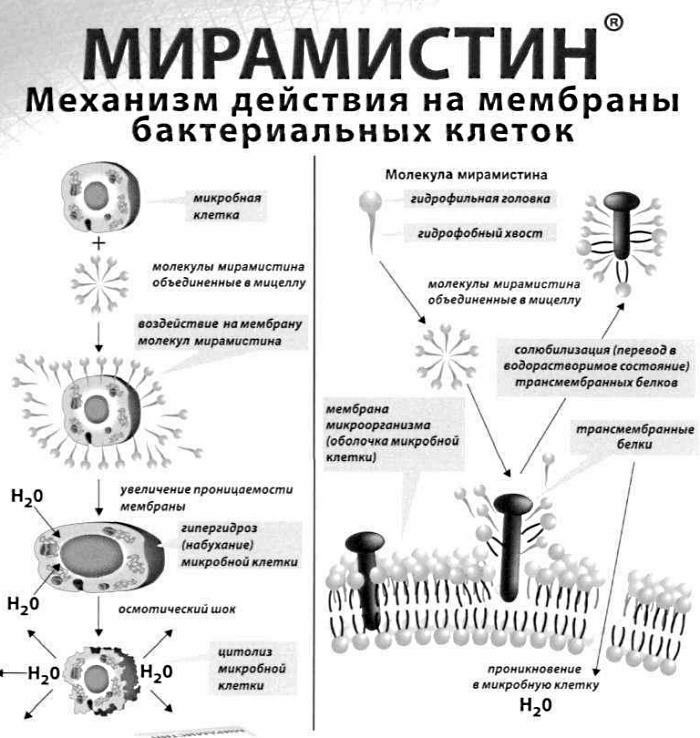Content
- Types of elastic bandages
- Why bandage your knee
- Bandaging methods
- Circular method
- Spiral method
- Turtle method
- How to choose an elastic knee bandage before running?
- Sprained bandage
- Knee bandage technique
- How long does the bandage wear?
- Tips for Using Elastic Knee Wraps
- Elastic knee bandage video
The advantage of elastic bandages over inelastic in that they are easier to handle. They can also be used by people who do not have special training. For example, with the help of such a bandage, the patient himself can bandage the knee while stretching.
Types of elastic bandages
The classification of elastic bandages is shown in the table below.
| Types and sizes of elastic bandages | |||
| A type | Bandage formation | Action | Advantages |
| Suture | Can be customized to your size. | Fixation, pressure | It can be customized in size and is convenient. |
| Seamless | By tightening the bandage. | High compression | Cost-effective, easy to form a dressing. |
| Short | Several circles | High compression, like a muscle, pumps blood. | Used for vascular insufficiency. |
Long |
Seamless type can be used. | High elongation, fixation. | Supports tendons and muscle ligaments. |

Elastic bandages can be divided into 2 main types:
- Foot, flat, knitted with a seam. The shape is achieved by changing the number of needles. This type can be tailored to your individual size and allows you to increase and decrease the number of stitches for each row. Therefore, the tension of the threads may not change when the circumference changes.
- Knitted and seamless. For this type, the only way to form a bandage is to vary the density and tension of the bandage.
Elastic bandages are usually 2 to 6 inches wide. The wider the bandage, the more compression is achieved without blocking actual blood flow. As a rule, a 6 or 8 cm bandage is used for an adult arm or leg.
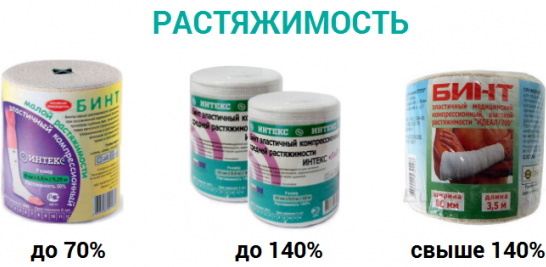
Also, bandages are divided into short and long:
- Short Elastic bandages are made from 100% breathable cotton. Due to the technology of their weaving, the use of such a bandage results in a higher compression. They are more efficient at higher operating pressures. Reusable and easy to clean, they ultimately prove to be quite economical for people suffering from venous edema, lymphedema, and post-traumatic edema. Most often, short elastic bandages are used for vascular insufficiency, as they act like the calf muscle, pumping blood or lymph to the heart.
- Long Elastic bandages have fibers that stretch as the swelling increases. They are highly elongated and highly responsive. Most often, long elastic bandages are used to heal stretched areas of the body. They are often used to provide support and relief to tendons, ligaments, and muscles. Depending on the type of dressing used, the elastic systems may need to be removed at night, as the pressure they exert is difficult to bear during sleep.
Why bandage your knee
The variety of compression therapy methods is reflected in different compression schools in different countries. For example, in France, elastic compression is usually prescribed: mainly elastic stockings and elastic bandages.
Elastic bandages and stockings are used as standard treatment in Germany and Austria. However, inelastic compression is usually prescribed, such as bandaging the knee.
Although the type of compression therapy may differ from country to country, it is most often the standard treatment for venous insufficiency. However, in the United States, compression stockings are rarely prescribed for chronic venous insufficiency or after sclerotherapy, and compression dressings are never prescribed.
Depending on what function the medical bandage performs, the following types are distinguished:
- Aseptic - to prevent substances from entering an open wound.
- Medicinal - provides constant access to the wound for medications.
- Hemostatic - stops bleeding.
- Immobilization - to fix a part of the body.
- Fusion - provides fixation and fusion of bone fragments.
- Corrective - eliminates deformation of a part of the body.
- Occlusal - seals an open wound.
In medical practice, elastic bandages are used in 4 directions:
- To create compression for varicose veins. This prevents their further expansion, reduces blood stagnation and the formation of blood clots.
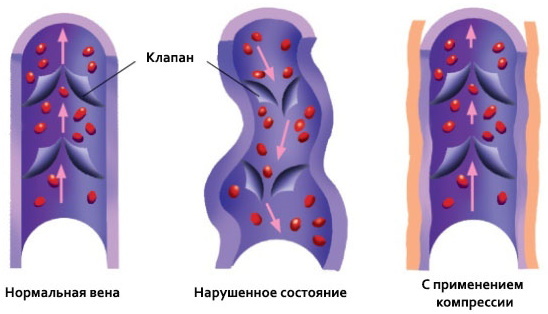
- For immobilization in case of injuries of the joints of the upper and lower extremities, excluding fractures, when not elastic, but tight fixation is required.
- For fixing bandages on wounds in problem areas of the body.
- For compression bandaging of limbs before the upcoming abdominal surgery to prevent blood stagnation and thrombosis.
People with varicose veins need to be especially careful when applying a bandage. It is necessary to strictly follow the instructions of a specialist.
An elastic bandage applies gentle, even pressure to the tissue around the injury to reduce pain and swelling. It also provides support to the injured area.
Elastic bandages are used in the following situations:
- To improve blood flow to the limb.
- Wrap the splint around the limb during healing.
- Fix cold or hot compresses.
However, assigning appropriate compression is a problem. It must be adapted to the patient and his pathology, while being the best compromise between high pressure on the body area, patient comfort and appropriate treatment.
Bandaging methods
For bandaging the leg, an elastic bandage with a width of 7 cm or more is used.
The bandage on the leg and its application can be done in a spiral or in eights. You can also bandage the body in a spiral or eights. To narrow the veins, the pressure under the bandage must be at least 40 mmHg. Art.
There are three main types of knee bands you can use to wrap your knee with an elastic bandage: circular, spiral, or turtle.
Circular method
In this case, the bandage begins and ends with an elastic bandage. This bandage is convenient for small wounds located on the phalanges of the fingers, in the frontal region of the head, in the lower third of the leg, on the wrists and on the elbow.
Rules for using circular bandages:
- The first circle is wound at an angle of 30 ° to the area of the body on which the bandage is applied;
- Make sure that the end of the bandage material is about 5-10 cm across the entire body area to be bandaged.
- When winding the first circle, the remaining end of the bandage is folded, then it is fixed through subsequent turns of the material used for dressing.
- To avoid displacement of the bandage, each new circle is overlaid more tightly than the previous one.
- Each new circle of the bandage should cover the previous one.
Spiral method
You can use a spiral bandage to bandage the knee with an elastic bandage. This type of bandage is used for parts that vary in thickness. These are, for example, thigh and caviar.
The spiral turns right around the limb. Care should also be taken to ensure that each new circle occurs directly above the previous one, so that the spiral pattern turns out to be even. Each turn should cover two thirds of the previous one.
Rules for using a spiral dressing:
- The patch starts with a circular bandage (slightly away from the injury).
- If a spiral dressing is applied without excesses (shoulder, hip, chest), use an elastic bandage.
- If a spiral bandage with bends (forearm, lower leg) is applied, then they are done exclusively, trying to make the application of the plaster detached from the damaged area.
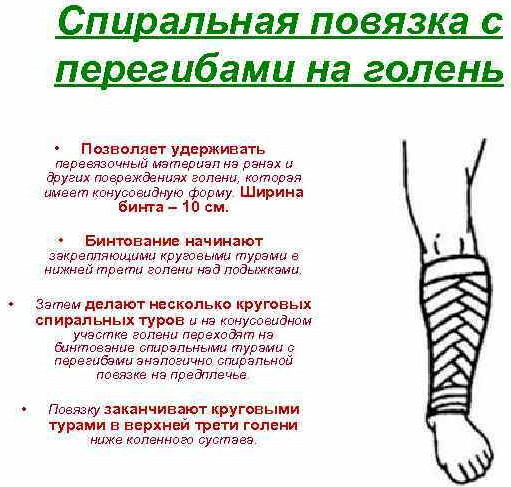
- If, when applying a spiral dressing that does not have kinks, it is not possible to achieve full compliance with the plane dressings with the surface of the body, it is necessary to make several bends with a further transition to a spiral dressing without kinks.
Turtle method
The turtle bandage is most commonly used on an injured knee or elbow. A significant advantage of turtle bandages over other types of bandages is reliable fixation of the wound dressing (bandage) over the damaged area of the knee or elbow joint, thereby further limiting the mobility of these joints.
Turtle bandage rules:
- Dressing begins with a circular bandage.
- Each new circle is crossed and alternated with a circular bandage shape.
- In this case, the bandage is removed and the new circle is moved in the proximal direction from the first circular bandage.
How to choose an elastic knee bandage before running?
Professional athletes often use elastic bandages for joints to prevent sprains and dislocations. For minor injuries, self-adhesive bandages are suitable, they provide fixation and retain the ability to move.
In order for the bandage to be selected correctly, you must:
- Consult a specialist, trainer, doctor.
- In order to choose the right dressing, it is necessary to take into account the material from which it is made. So, an elastic bandage based on natural materials will allow air to circulate freely and will not cause irritation.
- It should be understood that this product is used not just for bandaging the legs, but for the treatment of certain pathological conditions or their prevention.
- Each medical device should only be used for medical reasons.
 In case of difficulties in the selection, you can consult a pharmacist at a pharmacy. An experienced specialist will tell you more about bandages and help you decide on the most suitable option.
In case of difficulties in the selection, you can consult a pharmacist at a pharmacy. An experienced specialist will tell you more about bandages and help you decide on the most suitable option.
Sprained bandage
It is also necessary to bandage the knee with an elastic bandage when stretching the ligaments of the leg.
Sprained bandage is applied as follows:
- The joint should be slightly bent.
- The end (tail) of the bandage is placed on the inner side of the joint.
- The bandage is pulled to the outside of the ligaments and made one and a half turns so that the end of the bandage is tightly covered and does not loosen.
- Then make a figure eight around the joint, wrapping the bandage diagonally above and then below the joint.
- Bandage with the number eight, but each time only cover about 2/3 of the previous layer. With each new layer, only one third of the new skin is thus covered.
First aid and treatment for sprains or joints:
- Apply ice immediately to reduce swelling. To do this, the ice is wrapped in a cloth.
- A bandage is wrapped around the affected area to restrict movement of the joint. It is necessary to wrap tightly, but not tightly. Sometimes a bus is used.
- The swollen joint is kept raised above the heart. Even while sleeping.
- The affected joint needs rest. At least a few days.
- Aspirin, ibuprofen, or other pain relievers may help prevent joint pain
An elastic bandage is applied to the affected area until the pain goes away. In most cases, a mild sprain will heal in 7-10 days. It may take several weeks for the pain to go away after a severe stretch. A doctor may recommend crutches. Physical therapy can help restore movement and strength to the affected area.
Knee bandage technique
The bandaging process can cause pain in an injured person, especially in children. Before applying a bandage, it is necessary to mentally prepare the patient, to calm the child. The successful application of the bandage is possible only when the victim is calm.
It is important to cross the bandage in the center of the knee joint. To properly fix the knee, you must take a sitting or upright position. Begin to apply an elastic bandage from the calf. Wrap the knee tightly.
Knee bandage technique:
- Bend the knee, place the outside of the bandage over the knee and make one straight turn over the patella.
- The band is wrapped around the knee, slightly lower and slightly higher.
- The edges of the bandage covering the kneecap are covered, as in the elbow and heel bandages.
- The turns are repeated below and above the joint until the entire knee is covered.
- The bandage is then secured in one straight turn around the thigh.
Each new layer should overlap the previous one by two to three centimeters. In order to check the reliability of the bandage, after the end of the bandaging, the elastic bandage is fixed and they try to take several steps.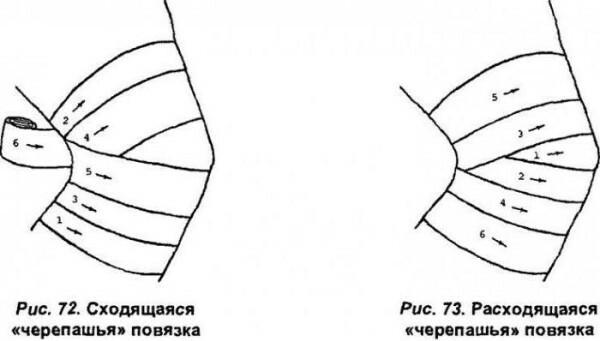
With the correct application of the elastic bandage, you can easily bend and unbend the leg, and the pain sensation will decrease somewhat.
How long does the bandage wear?
Recovery time for sprains of the knee joint depends on the severity of the injury.
| The time of wearing the bandage in relation to the degree of damage to the knee joint | ||
| The severity of the injury | Signs | Recovery time |
| 1st degree | With a grade 1 ligament injury, the ankle ligaments are overstretched. There is a little pain, swelling and tenderness. The joint can still be mobile. | 3 weeks. |
| 2nd degree | Some ligaments are torn and some remain intact. There is pain, swelling, joint instability, and difficulty standing on the affected area. Crutches are usually recommended to avoid stress on the injured leg. | 6 to 12 weeks. |
| Grade 3 | It is the most severe form of ligament injury. To this degree, all ligaments are torn and they usually require surgery. Due to the surgery, it takes longer for them to heal and adjust to the new structure that has been attached to help with the healing process. | 4 to 12 months. |
Treatment time is reduced if the patient is accompanied by a competent physiotherapist. He prescribes a certain treatment, which includes: exercises, massages.
Physiotherapy prepares the injured knee joint to return to the pre-traumatic phase. The physical therapist will assess the injury and develop realistic goals with the patient, the ultimate goal of which is to make the ankle behave as if it had never been injured.
Tips for Using Elastic Knee Wraps
General rules for the use of elastic bandages:
- Hold the roll with the bandage in your right hand. He held the end of the bandage in his left hand.
- When applying a bandage, you need to use 2 hands. With one hand, the roll is rolled without tearing it off the surface of the body, and the bandage is straightened with the other.
- In the process of dressing, the types of which depend on the specific situation, you need to face the victim. This will allow you to control his condition.
- The bandage is applied from top to bottom, from the place where the diameter of the body surface is smaller.
- The first winding must be fixed, making a slight bend of the bandage in the place where it began. Over this place, make another loop of the retainer. With each subsequent winding of the bandage, make half of the previous one.
- When the dressing is finished, the end of the bandage needs to be cut a little lengthwise, forming two parts. Then carefully tear the cut bandage, creating two small pieces. A knot was tied from them.
Experts recommend:
- Do not tighten the bandage too tight, as this may block blood flow.
- Remove the bandage at least 2 times a day. The damaged area must be left for a few minutes.
- Ask your doctor if you should leave the bandage on overnight.
- If the patient feels numbness or tingling in the limb, the bandage will need to be removed. Likewise in cases where the leg becomes cold or pale. Wipe the area gently. It is better to apply the bandage after a time when the leg stops hurting, and to reduce the pressure.
- It is best to wash the bandage every day, or at least when it loses.
- It is recommended to have an additional elastic bandage with you in case the one wrapped around the knee gets wet or dirty.

It should not be tied up with going to the doctor. It is necessary to consult a specialist in order to assess the degree of damage.
It is necessary to consult a doctor if:
- have pain or cramps in the limb;
- Tingling or numbness that doesn't go away after the dressing is removed
- after removing the bandage, the leg remains cold or pale;
- there is redness that was not there when the bandage was first applied.
Elastic bandage provides compression. Compression is the deliberate application of pressure on a part of the body to achieve the desired clinical effect.
Most often, the compression effect is achieved by wearing elastic stockings or tights, as well as by bandaging with special elastic bandages to prevent swelling of the extremities and to treat a number of conditions, such as dislocation of the knee joint.
Author: Svitkevich Julia
Elastic knee bandage video
How to wind an elastic bandage for a bruised knee:



